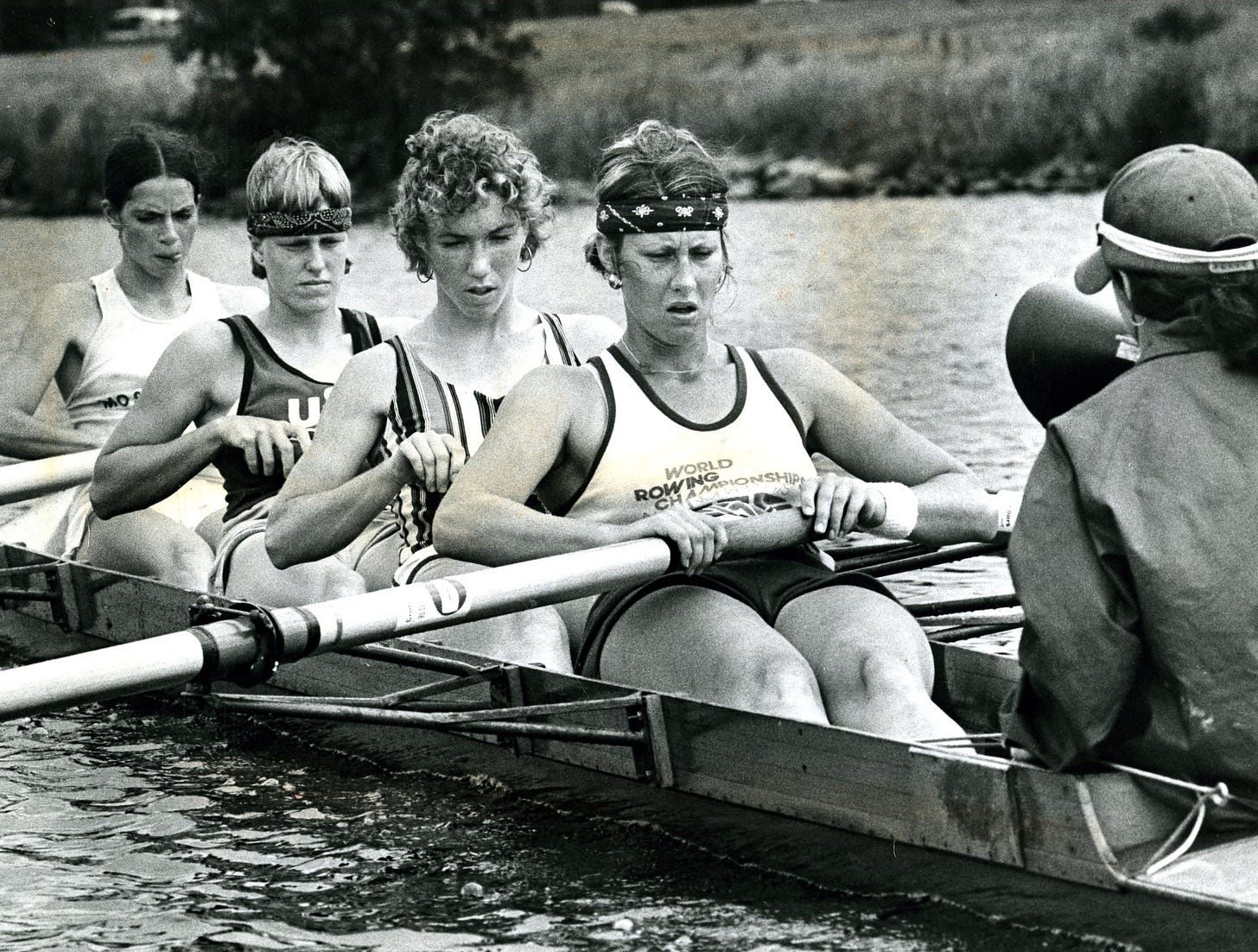The strip protest that put the spine in Title IX
Also? This is a long-overdue BOOK CLUB UPDATE!!!!!

Hello, everyone, and welcome to Power Plays, your no-bullshit home for sexism in sports.
As you might have noticed, the newsletter has been in a bit of an August lull, but things are gearing back up. Today’s newsletter is a combo book club/archival dive/interview about a pivotal 1976 Title IX strip protest by the Yale women’s crew team, you’re going to love it.
A quick programming note: I am going to be taking a break until after Labor Day to work on longer-term projects, but I have a few freelance pieces lined up and am pre-writing a few newsletters myself, so your inbox will still be full of Power Plays at least twice a week.
And I’ll still be around the interwebz, as I’ll be stopping by for our Power Plays Book Club discussion, and hanging out in the Power Plays Slack channel to panic over WNBA results.
My main priority right now is getting back on track with the Power Plays Book Club! Our current book is “Course Correction: A Story of Rowing and Resilience in the Wake of Title IX” by Ginny Gilder. If you haven’t read it yet, I highly recommend it!
I had a phenomenal conversation with Gilder — who, in addition to being an Olympic rower, is also the co-owner of the Seattle Storm — this week, and will be sharing that full interview with you all next week. Trust me, it’s worth the wait.
HERE ARE A COUPLE OF VERY IMPORTANT POINTS TO READ BEFORE PROCEEDING:
Help me schedule the “Course Correction” discussion: I want to pick a time for the “Course Correction” discussion that works best for everyone who wants to participate. Please click this link, which will take you to a Google Form, and put a check mark next to every time that works for you! We will have the discussion in an open thread right here in Power Plays, so you won’t need video or audio access to participate. The thread will remain open, and you’ll be able to chime in at any time, but it’s much more fun if there are enough people present to have an actual discussion!

*** I could not embed the form, the above photo is just a screenshot, click here to fill it out. ***
Join the Power Plays Slack: Just like the Book Club, the Power Plays Slack is a perk that is only available to paid subscribers — which, if you’re reading this, means you! If you’re not familiar with Slack, it’s basically just a private chat room where we watch women’s sports together and keep up-to-date on news. It’s fun.
I’m going to get caught up on sending out invites tomorrow, so now is a good time to e-mail lindsay@powerplays.news with “Power Plays Slack” in the subject line, so I can send you the sign-up link.
Okay, that’s plenty preamble. Let’s do this.

“These are the bodies that Yale is exploiting”

(PIC: The 1976 Yale University rowing team, right to left, Gloria Graz, Jackie Zoch, Nancy Storrs, Chris Ernst and Carol Brown; via Getty Images)
In 1975, when Ginny Gilder was a freshman at Yale University, she fought her way onto the Yale crew team and fell in love with the sport of rowing. Even though Title IX was enacted in 1972, Yale — like most schools — wasn’t exactly in a hurry to invest equally in women’s sports.
The women’s team was coached by Nat Case, a former Yale rower who was only paid $500 a year. The women practiced with old equipment, and were harassed endlessly by their male colleagues in the weight room.
But the biggest problem facing the women’s team? Bob Cooke Boathouse, the Yale rowing facility, didn’t have any locker rooms or showers for women. The boathouse was so far off campus that the men’s and women’s teams had to be bussed back and forth. Every day after practice, even in the winter, the soaked women loaded onto the bus and waited for the men while they showered and changed.
"Fifteen to twenty minutes after the women got on the bus, sweaty, soaked, and, by now, often shivery, the men would straggle on, clean, hair freshly combed, wrapped in warm jackets, and eager to hit the dining hall for dinner,” Gilder wrote in “Course Correction.”
“No matter the weather, weather, we waited for the men in wet clothes, we endured the bus ride back to campus in wet clothes, we ate our meals in wet clothes, and we walked back to our dorm rooms in wet clothes.”
The university had promised to transform the boathouse’s unused third floor into a space for the women to shower, but the project ended up being too costly. They compromised by providing a temporary trailer with showers that would be parked in the boathouse’s parking lot. But the occupancy permit was delayed, so there was nothing in place for that season.
Meanwhile, the female rowers were catching colds, even pneumonia, waiting on the cold bus in their wet clothes. But it was there, on the bus, shivering, waiting, that the women devised a plan — a plan that started out as a joke between captains Chris Ernst and Anne Warner, both members of the 1975 U.S. world championship team, but quickly turned serious.
Ernst, a senior, wanted the team to march into the office of Joni Barnett, the director of women’s intercollegiate sports, and strip naked to get her attention, to show her how dire the situation was. And so, that’s exactly what they did.
On March 3, 1976, 19 female rowers gathered in the basement locker room at Payne Whitney and prepared to make a statement.
Here’s how Gilder describes the morning in “Course Correction:”

(Honestly, the fact that Barnett’s first question was whether the male reporter should be in the meeting has me HOWLING.)
It certainly is a good thing that Zweig was present that day; Haight, too. Here’s the photo of the meeting, which I found in the Yale Daily News archives. The fully clothed woman is Barnett, while the shirtless woman facing her and reading is Ernst. (You can see a clearer version of the photo in this article.)

And here’s the article that ran the next morning, on March 4, 1976, in the New York Times:

Anne Warner’s quote, that the women would probably only have hot showers “when Peter Pan comes back to life” is an absolute classic. Thankfully, because of the protest, it didn’t take quite that long to see a change.
The story instantly made waves nationally, and press from all over swarmed to New Haven to cover it. A week later, the New York Times printed an update.

The strip protest has gone on to be one of the defining moments of Title IX. You can find out much more about it, not only in “Course Correction,” but by watching the documentary about that day, “A Hero For Daisy,” or reading this ESPN feature, “Title waves,” which was published in 2012 in honor of the 50th anniversary of Title IX.
I absolutely loved what Gilder wrote about what the protest meant to her in the moment — how invigorated she was by standing up for herself and her teammates, by apologetically taking up space.

This week on zoom, I asked Gilder whether when she was standing there topless in Barnett’s office, she sensed that she was participating in a pivotal moment for women’s sports as a whole. Here’s part of her response:
Oh, God, no. I think this is really how life works. You know, I was 17, okay? Seventeen years old. I skipped my senior year of high school, I shouldn't have been in college yet. And there was Chris Ernst, captain of the crew, saying, ‘We're going to do this.’ I'm like, ‘Okay. If my captain says we're doing this, I'm doing it.’
Of course, she was educating us about Title IX, and we were living through the experience of going to the boathouse and seeing the guys trotting through the locker room and doing their thing, while we went to sit on the bus and wait for 20 minutes while they're showering. That was an experience we had, and I wrote about my experiences with the heavyweight men, that was real. So it wasn't like I had to conjure up a sense of outrage. The outrage was there.
Plus, you know, talk about privilege — Upper East Side, New York City, private school, boarding school white girl. Legacy family, my dad had gone to Yale, my grandfather had gone to Yale. So I'd never been discriminated against in my life. I was, in some ways, the most outraged, given my background.
But for me, it was a very, very important piece of my own growth as a human, and probably really set me on the road to recognizing how important the fight for equitable access to opportunity is. But at the time, we had no idea. No idea that alums would start writing and calling the president of the university, no idea that it would actually go around the world as an article, no idea that many, many athletic directors across the country would be calling their coaches and saying, ‘Is this going to happen at our school?’ None.
I’m going to save the rest of Gilder’s response for an upcoming newsletter, because she ties that protest back to some of the activism happening in the WNBA today, and I want you all to be able to read those thoughts in their full context.
But I’ll finish with this fun nugget: Today, where the Bob Cooke Boathouse used to sit, there is a 22,000 state-of-the-art facility for Yale crew, which I can guarantee has equal accommodations for men and women. Its name? The Gilder Boathouse.

Thanks so much for reading, friends! Don’t forget to fill out this super quick survey so I can schedule the “Course Correction” discussion.
And, as always, if you had fun here, please consider clicking on the button below and spreading the word.


hmm ... it might just be me but I'm getting a message that the form can only be viewed by users in the owner's organization.